Introduction
Over the past few decades, some advancements have been undergone in the business world. The growth of information technology (IT) recently led us to the trend of e-business, impacting manufacturers to automate their internal operations (Foley et al., cited in Park 2005). As the business focus shifts and the e-business grows, enterprises have to adjust themselves by implementing IT systems in their businesses. Some efforts to automate business processes for example through e-procurement system that’s proven to provide benefits to the organization (Hidayanto et al. 2012a). In addition, the development of more sophisticated IT infrastructure also allows organizations to focus on their core business through technology such as Software as a Service (SaaS) (Hidayanto et al. 2012b), cloud computing and so on. However, another effort that had been done for a long time is through the development of integrated application infrastructure named Enterprise Resource Planning (ERP).
The ERP system is an integrated, all-encompassing (Markus & Tanis, cited in Sammon 2005) and complex mega-packages (Gable et al., cited in Sammon 2005) system designed to support the key functional areas of organizations. ERP supports organizations to determine the logistics of its strategy, management and culture. Through the advances in information technology, ERP also hits the business market and assists organizations to enhance their decision by increasing precision in decision making and reaching competitive advantages (Jeffery & Morrison; Brady, Monk et al., cited in Laframboise 2002).
The importance of ERP in supporting business and supporting organizations’ needs encourages many companies to make IT investment by implementing ERP into their IT systems. Since early 1990s, collective ERP investment by organizations worldwide has reached the approximate value in hundreds of billion dollars (Staehr 2007). Furthermore, ERP also one of the fastest growing markets in the software industry with long-term growth rates of 36-40% with estimated put the eventual size of the market by the year 2010 at US$1 trillion (Bingi et al., cited in Park 2005). This large amount of investment shows that ERP investment is one of the important issues in the current industry to gain the competitive advantage.
Unfortunately, in comparison to its usage, these large investments are not always profitable. ERP implementations are known to be very diverse and risky. Some organizations are very successful in implementing ERP systems (Davenport, cited in Staehr 2006) while many other organizations, like FoxMeyer, suffered disastrous business consequences (Bulkeley, cited in Staehr 2006). As the value of ERP investments grows and the ERP implementations’ result tends to be varied, an evaluation of the ERP systems is a crucial matter to do. This importance is shown through a survey conducted to 625 CFOs which it is listed as the second important issues in organizations (CSC, cited in Schubert & Williams 2009).
With respect to that, this research aimed to propose an evaluation method using the catalog of the benefits of ERP systems, based on ERP Benefit Dimensions of the Shang and Seddon (2002) and Information Systems Benefit Framework of Ranti (2008), to determine the benefits perceived by the company after implementing the ERP systems. The benefit evaluated in five dimensions, namely: operational, managerial, strategic, IT infrastructure, and organizational. In order to get insight of such catalog of ERP implementation benefits, we conducted analysis in an agricultural company in Indonesia that has implemented ERP for years. Agricultural is considered as one of Indonesia’s main export commodities, therefore study on such sector will give significant impact to the agricultural development.
The remaining sections of this paper will be organized as follows. We first describe the theoretical hypotheses used in this research. Second, we discuss about the methodology of ERP evaluation proposed in this research. Third, we present the results of the ERP benefit analysis from our case study. Finally, conclusions and suggestions for further research are provided in the last section.
Literature Review
ERP Definition
Recognized as the most imperative information technology (IT) infrastructure of modern companies (Shar et al., cited in Park 2005), ERP has many definitions proposed by people from all over the world. However, from the various definitions proposed, there is no agreed-upon definition for ERP systems.
Based on Markus and Tanis (cited in Sammon 2005), ERP systems is an integrated, all-encompassing, complex mega packages (Gable et al., cited in Sammon 2005) designed to support the key functional areas of an organization. As from Watson and Schneider (cited in Sammon 2005), ERP is a generic term for an integrated enterprise wide standard information system in the form of customized, packaged, software-based system that handles the majority of an enterprise’s information systems’ requirements and facilitates the flow of information among all functions within an enterprise, can be further defined as a strategic business solution that integrates all business functions, including manufacturing, financial, and distribution.
According to Kumar et al (cited in Eckartz 2000), ERP systems are packaged software applications that support most of a company’s information needs within and across functional areas in an organization. Meanwhile Nah and Lau (cited in Al-Fawaz, 2008) defined ERP as “a packaged business software system that enables a company to manage the efficient and effective use of resources (materials, human resources, finance, etc.) by providing a total, integrated solution for the organization’s information-processing needs”. Similar with Nah and Lau, Hect et al. (2011) also defined ERP system as integrated information system software compromised of several modules share a central database that helps automate and integrate business processes and practices within a firm, and provides support for core organizational activities such as manufacturing, finance and accounting, sales and marketing, and human resources. This software facilitates, if well-implemented, the integration of all the functional information flows across the organization into a single package with a common database. Therefore, it allows easy and immediate access to information regarding inventory, product or customer data, and prior history information (Shehab et al. 2008)
ERP Benefit
Due to the widespread use of ERP systems, with various backgrounds such as technical gains e.g. replacing legacy systems, or for business reasons e.g. improving operational performance and efficiency (Nicolaou, cited in Elragal & Al-Serafi 2011), many researchers have high interest in investigate the issue of ERP benefits. Using a number of approaches, including an experiment, archival, financial data analysis and interview, several research studies have identified various important benefits the ERP systems bring to organizations.
One of the ERP benefits is operational improvement. As a collection of highly integrated subsystems, ERP systems can be described as ‘tightly coupled’. To be sure, tight coupling facilitates coordination among subsystems and solves the fragmentation of information (Davenport, cited in Park 2005). As a result, it streamlines a company’s data flow and provides management with direct access to a wealth of real-time operating information. For many companies, these benefits have translated into dramatic gains in productivity and speed of business operations.
Another ERP benefit is stated by O’Leary (cited in Al-Fawaz 2008). O’Leary (cited in Al-Fawaz 2008) stated ERP as a system integrates the majority of the business processes and allows access to the data in real time. Furthermore, ERP improves the performance level of a supply chain by helping to reduce cycle times (Gardiner et al., cited in Al-Fawaz 2008). ERP also allows easy and immediate access to information regarding inventory, product or customer data, and prior history information (Shehab et al., cited in Al-Fawaz 2008)
In brief, by implementing the ERP system, an organization may enjoy intangible benefits including, better customer satisfaction, improved vendor performance, increased flexibility, reduced quality costs, improved resource utility, improved information accuracy and improved decision-making capability (Siriginidi, cited in Al-Fawaz 2008).
ERP Benefit Measurement
There are so many ERP benefits that have been claimed by research studies. Nevertheless, from all the benefits stated, not all the benefits can be gained by the organizations. Even a successfully adopted and implemented ERP system does not automatically guarantee full benefits. It is important that ERP is operated as planned and thus provides the real-time information with a desired level of process integration. Any ERP system pushes a company toward full process integration and solves the fragmentation of information (Park & Kusiak 2005). However, Companies often fail to reconcile the technological imperatives of ERP with the business needs of the enterprise itself (Bingi et al., cited in Park 2005) that lead to out-of-control or failed ERP projects (Davenport, cited in Park 2005).
Research indicates poor realization of the benefits received from the implementation of ERP systems in the organizations. Rutherford (cited in Sammon 2006) observed that only around 10% to 15% of ERP implementations deliver the anticipated benefits. Furthermore, research reported that 51% of organizations that attempted an ERP implementation were dissatisfied with the results with 40% of the projects failed to achieve their business case within one year of going live (Jahnke, cited in Sammon 2006). Numerous factors, either internal or external organization’s aspects (Elragal & Al-Serafi 2011), from unclear business strategies; cost overrun; project delay; underestimation of the required efforts for change management, risks, to overestimating of benefits become the reason why more than 70% of ERP implementations fail to achieve their estimated benefits (Nafeeseh 2011).
Considering its huge impact on the organization, coupled with a potentially high risk of project failure, it should be imperative that proper evaluation be undertaken on ERP projects (Teltumbde, cited in Sammon 2006). Therefore, identify, manage and realize the benefits of ERP and their contribution to business value then maximize the value got from the ERP investment are ongoing challenges for both research and the practical (Williams & Schubert, cited in Nafeeseh 2011).
However, justification of technology, including ERP, investment is never easy. An inappropriate investment appraisal can victimize a company in an overwhelming way (Borges & Tan 2007). This far, most of evaluation of technology investment done by evaluating the tangible benefits such as ROI methods, Cost-benefit analysis, Return on management, and information economics or any tangible evaluation methods (Wen & Sylla, cited in Mahmood et al 1999). Justification of technology investment should not be limited to tangible benefits evaluation but also including the intangible benefit, which could not be captured or converted into quantitative value, to an organization’s business value (Murphy & Simon, cited in Nafeeseh 2011). The intangible benefit evaluation done for determining all potential benefits company gets from an ERP implementation, including the benefits that are not derived from the ERP system itself but from the various ways the system can be implemented and used.
In 2002, Shang and Seddon develop a framework for assessing intangible benefit brought by the implementation of ERP system. This evaluation framework, called ERP benefits framework, was developed from a study of 233 vendor success stories published on the web, and interviews with managers in 34 organizations using ERP systems. The framework was validated subsequently using in depth case studies in four Australian utility companies (Staehr 2007). The framework provides a convenient means of identifying the business benefits an organization has realized in the post-implementation phase of the ERP system life cycle by presenting five dimensions of business benefits: operational, managerial, strategic, IT infrastructure, and organizational and multiple business benefit categories within each dimension. Table 1 summarizes ERP benefits framework by Shang and Seddon (2002).
Table 1: ERP Benefits Framework (Shang and Seddon 2002)
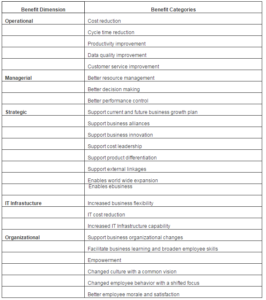
There are many frameworks that can be used for assessing benefit driven from ERP system implementation, including Ranti’s Generic IS/IT Business Value Category (2008). Generic IS/IT Business Value Category is a framework proposed by Ranti (2008) as the result of his research in identifying IS/IT business value resulting from the implementation of various IS/IT projects in various organizations in Indonesia. This research was done by conducting report from 60 cases of various IS/IT project implementation, including ten cases of ERP implementation, in various organizations in Indonesia using hermeneutic methods. The research shows the added values brought by the implementation of IS/IT projects to the organizations and classify those values into 13 categories and 74 subcategories as can be seen in Table 2. These categories and subcategories comprises various benefits brought by the IS/IT implementation that help the organizations to improve their organizational performance.
Table 2: Ranti’s Generic IS/IT Business Value Category (Ranti 2008)
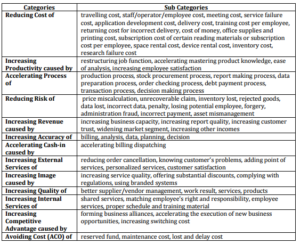
Research Design and Methodology
Our research comprised of two main phases. In the first phase, we formulated the catalog of ERP implementation benefits. This benefit catalog was developed by mapping the ERP benefits framework from previous studies. The second phase was framework validation, which was done by using the proposed catalog on a case study in a agricultural company that already implemented ERP system for years.
The Proposed ERP Implementation Benefit Catalog
We proposed ERP implementation benefit catalog to provide finer granulation of ERP benefits that can be used by the organizations as the reference for evaluating the benefit comes from ERP implementation and utilization. The proposed catalog was developed based on two frameworks from the previous study, ERP benefits framework (Shang and Seddon 2002) and Generic IS/IT Business Value Category (Ranti 2008). This mapping process is performed to create a comprehensive catalog that overcomes the previous framework limitations. ERP benefits framework of Shang & Seddon (2002) has broad coverage of ERP impacts on organizations manifest in the five dimensions: operational, managerial, strategical, IT infrastructure. It also identifies and defines a number of benefit categories. Nevertheless, it has narrow level of detail (Eckartz et al. 2009). Unlike Shang & Seddon’s ERP benefits framework, Ranti’s Generic IS/IT Business Value Category is more general. Ranti’s Generic IS/IT Business Value Category can be used for assessing benefit from various IS/IT projects implementations, incuding ERP system. Ranti’s Generic IS/IT Business Value Category does not have classified dimension but it also identify number of benefit categories like Shang and Seddon framework. Moreover, it provides great level of benefit detail shown in its subcategories. The combination of both frameworks make the proposed benefit frameworks have a broad coverage of dimensions, greater number of benefit categories and greater level of detail shown in subcategories.

Figure 1: Mapping Process to Develop ERP Implementation Benefits Catalog
The catalog is structured by mapping Ranti’s Generic IS/IT Business Value categories and sub-categories into Shang and Seddon dimensions and categories. The first step is finding mutual benefit categories between Ranti’s and Shang and Seddon’s framework then mapping the mutual categories from Ranti’s into Shang and Seddon. Then, the mapping continues by mapping subcategories to appropriate categories. The mapping process can be seen in Figure 1.
After all mapping process done, the comprehensive catalog is obtained. The comprehensive catalog consists of five dimensions and 25 categories from Shang and Seddon’s Framework plus 73 subcategories from Ranti’s Framework as can be seen in Table 3.
Table 3: The Proposed ERP Implementation Benefits Catalog
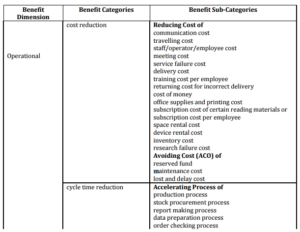
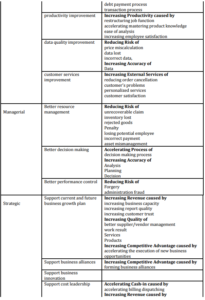
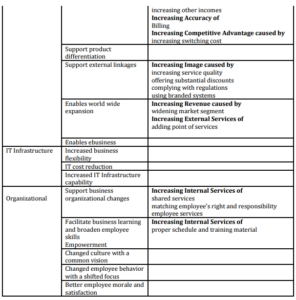
Framework Validation
To validate the proposed ERP implementation benefit catalog, a case study research was conducted in an agricutural company in Indonesia. This research conducted to identify the benefit gap perceived by the company before and after the ERP systems implementations using the proposed benefit catalog as the research instrument. The research is undertaken using qualitative approach, which focusing on operational and intangible benefit to get better outline of the relationship between ERP system and the business performance (Velcu, cited in Elragal & Al-Serafi 2011), with the primary sourced data from in-depth interviews. Interviews were performed according to the proposed benefit catalog, which then is operationalized into 75 open ended questions aligned with the categories of the implementation and the operation of ERP system in five dimensions: Operational, Managerial, Strategical, IT Infrastructure, Organizational.
For the interview, some key informants have been chosen. The selected informants come from various divisions and positions that related to the implementation and operation of ERP system in the company. The key informants are Reporting & Corporate Planning Manager, Head of Business Support Subdivision, Accounting Staffs, Marketing Staffs, Procurement staffs, and IT staffs. The key informants are the employees that have been directly involved in ERP project planning, ERP System implementation or the operation of ERP system. Each informant has a different and specific role. Furthermore, every informant have different experience and obtain different advantage from the ERP system implementation. Reporting & Corporate Planning Manager has the role in planning phase and directly involved in planning and the implementation process. As one of the top level management, he also is affected by ERP implementation and gains advantages of it. Head of Business Support Subdivision is the one who is responsible in the implementation and the operation of ERP. He is responsible to make sure that ERP system supports the business need. In this sense, he also understands the benefit brought by the ERP in both business and technical perspectives. For the staffs, either the accounting, marketing, or procurement, they are ERP system users. As their works are fully supported by the ERP system, they also get some benefits of ERP implementation. The IT staffs, they are in charge of technical support for the ERP systems operational. They acknowledge ERP impacts in technical perspective, including the infrastructure.
Profile of Case Study
The case study research was held in an Indonesia top leading company enganged in agricultural sector. The company, named PT.XYZ to preserved anonimity, is a public company incorporated in one of top international companies group that has been focused on palm oil business for decades. As one of the top companies incorporated in international group companies, PT. XYZ constantly encouraging development and improvement to manage its business and meet its vision“to be most productive and innovative agricultural company in the world”.The company’ development including the information technology and information system area. The IS/IT development performed by PT. XYZ with implementing the ERP Systems. The ERP Systems implemeted to transform the company systems from the sole system to integrated systems and expected to support company in improving the coordination and information management aspects to meet the demand of high-quality data. Start planned at 2004, the ERP Systems finally operated by the company in 2007 after the implementation phases completed at the head office and more than 40 branch offices located in all over indonesia from Sumatra, Java, Kalimantan to Sulawesi island. After more than four years utilization, the company willing to evaluate the benefits of the ERP Systems to measure the ERP implementation success. Therefore, this case study was conducted in PT.XYZ to measure the company ERP implementation success through the catalog of ERP benefits formulated.
Analysis and Discussion
The following section describes the results of validation of our proposed ERP implementation benefits catalog in the selected company. As in the our proposed catalog, the benefits of ERP implementation in the case study were analyzed and classified into 5 dimensions based on Shang and Seddon’s framework. Each dimension is further detailed into several categories and subcategories. A subcategory benefit was concluded to be perceived by the company if more than half of the respondents are agree about the benefit.
Operational Dimension
ERP system implementation in PT. XYZ has impacts on various dimensions, including the operational dimension. The implementation of ERP system transformed the operational processes in the company, from manual and stand-alone operation to become automated and integrated operation. Thus, this transformation gave the company several benefits. One of the benefits brought by the ERP implementation in operational dimension according to the informants is cost reduction. The followings were informants’ response regarding our question to cost reduction aspect, that we used as the basis to conclude whether the company feels the benefit of ERP implementation or not in such aspect.
Head of Business Support Sub Division:
“Before the ERP implementation, some sites were still using the manual process and the other sites were using sole system. If the head office needs transaction data from a particular site, it cannot be directly accessed. The head office needs to call the site and the call will be forwarded to many parties which are responsible for the data. However, in some cases, the head office often cannot get the transaction data required. After the implementation of ERP, some processes change. The transaction data have to be inputted to the system every day, so that whenever the head office needs the data, they can obtain the data directly as the site is connected directly to the head office. Hence, the calls needed from the head office to the site can be minimized. As the impact, the communication costs can be reduced.”
Procurement Staff:
“After using ERP systems, PO (purchased order) and PR (purchase requisition) can be directly accessed by the site without the head office needs to call the procurement division on every site in Java, Sumatera, Kalimantan, and Sulawesi.”
Accounting Staff:
“The accounting division is responsible for making monthly report. The head office makes the report based on monthly report from the site. Before using ERP systems, accounting division needs to call the sites for asking the monthly reports as these sites often late to sending the report. After using the ERP system, there is a deadline for inputing the data and generating the monthly report. All sites have to input the data on time or they cannot input the data at all, hence we do not have to call the sites and asking for the report.”
After analyzing these informations and other responses regarding the communication cost reduction, it can be concluded that the company perceives benefit in communication cost reduction category. Other aspects can be concluded with the similar way.
The further details for the operational dimension benefits obtained by the company are summarized in Table 4. Symbol
“” in the third column indicates that the company perceives benefit as shown in the second column.
Table 4: Benefits Perceived by PT. XYZ in Operational Dimension
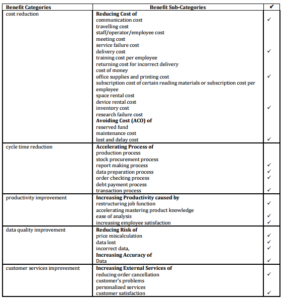
From 37 benefit sub-categories listed, there are 19 sub-categories earned by the company in the operational dimension. Moreover, we also can see that the company also feels the benefits of ERP in 5 categories. Most of benefits perceived by the company are in the operational dimension.
Managerial Dimension
Implementation of ERP system also has some impacts on managerial dimension. As, a multifunctional system, ERP supports many company’s bisnis processes including managerial processes. The integrated system and functions provided bring the process improvement to the company and help the managerial to perform better resource management, more accurate decison making and better performance monitoring.
The detail about the managerial dimension benefits obtained by the company is presented in Table 5.
Table 5: Benefits Perceived by PT. XYZ in Managerial Dimension
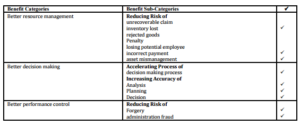
From 13 benefit sub-categories listed, there are 9 sub-categories earned by the company in the managerial dimension and from 3 benefit categories listed the company gets all benefits of these categories.
Strategical Dimension
ERP system also has influence on strategical dimension. ERP system is capable to improve company’s strategic dimension that supports company’s future growth. Table 6 shows the ERP benefit on strategical dimension.
Table 6: Benefits Perceived by PT. XYZ in Strategical Dimension
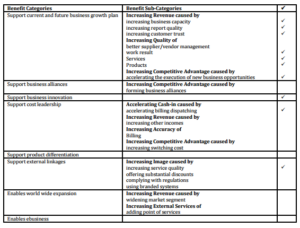
Among 19 benefit sub-categories and 8 benefit categories listed, the company perceives 10 sub-categories and 4 benefit categories respectively in the strategical dimension.
IT Infrastructure Dimension
IT infrastructure dimension is one of the dimensions that also affected by the implementation of ERP system. According to our mapping, there are three benefits of ERP system in this dimension. However, based on our interview, the company only considers 1 benefit as the impact of ERP system which is ERP increases IT Infrastructure capability.
Table 7: Benefits Perceived by PT. XYZ in IT Infrastructure Dimension

Organizational Dimension
We also proved whether the company perceives benefits of ERP system or not in the organizational dimension. According to our proposed catalog, we have 5 categories and 7 subcategories. Among these categories and sub-categories, the company perceives benefits of ERP system in 5 categories and 5 sub-categories as can be seen in Table 8.
Table 8: Benefits Perceived by PT. XYZ in Organizational Dimension
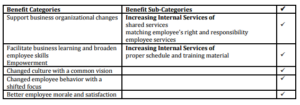
Study Limitations
This study only considers the intangible benefit of ERP implementation perceived by the organization. To gain more understanding on ERP implementation benefits, there should be also more extensive study on tangible benefits. The validation of our proposed ERP benefit catalog is also conducted in one company. To get more general conclusion, we still need to involve many organizations in our study. However, as the main objective of this study is to provide a catalog for ERP benefit evaluation, and the ERP catalog benefits can be applied in the organization, this ERP catalog benefit seems likely to be useful for in evaluating ERP intangible benefit in organizations. For future study, a similar study with combination tangible benefit would allow more comprehensive evaluation of ERP benefit in organization. More detail study also can be taken to know the factors that make those benefits gain by the organizations.
Conclusion
This research aims to propose a catalog of ERP implementation benefits that can be used by organizations to measure the success of their ERP implementation. The proposed catalog was developed by combining five dimensions of Shang and Seddon’s ERP benefits framework and 73 subcategories of Ranti’s Generic IS/IT Business Value Category, thus it produced 25 categories and 73 sub-categories of ERP implementation benefits. In order to see the applicability of our proposed catalog, we tested it through a case study in agricultural manufacture company. Based on the analysis we performed, it can be concluded that the ERP implementation in the company provides benefits in operational, managerial, strategical, IT infrastructure, and organizational dimensions. Although the company does not gain all proposed benefits in the catalog, they still perceive benefits of ERP system in 19 categories and 41 sub-categories. Of the five dimensions we evaluated, the company gains most of benefits in operational dimension. The results of our analysis confirm the applicability of our proposed catalog of ERP implementation benefits. Thus, it can be applied in any companies to evaluate the performance of ERP implementation.
Acknowledgment
This research is supported by Universitas Indonesia through ‘Riset Madya’ grant No. 2139/H2.R12/HKP.05.00/2012. It is a pleasure to convey our gratitude to our university for their continuous support, particularly for Research and Public Service Directorate for their excellent services. We also thank to IMHERE project officers for their support in disseminating the results of this research. We hope that we can produce high quality results from this research.
(adsbygoogle = window.adsbygoogle || []).push({});
References
Al-Fawaz, K., Al-Salti, Z. & Eldabi, T. (2009). “Critical Success Factors in ERP Implementation: A Review,” Proceeding of the European and Mediterranean Conference on Information Systems 2008 (EMCIS 2008), 25-26 May 2008, Dubai. [Online], [Retrieved 2 Agustus 2011], http://bura.brunel.ac.uk/handle/2438/3336
Publisher
Abu Nafeeseh, R. & Al-Mudimigh, A. S. (2011). “Justifying ERP Investment: The Role and Impacts of Business Case A Literature Survey,” International Journal of Computer Science and Network Security (IJCSNS), vol.11 no.1. [Online], [Retrieved 16 October 2012], http://paper.ijcsns.org/07_book/201101/20110128.pdf
Publisher
Borges, L. A. & Tan, K. H. (2007). “An Intangible Benefits Approach to AMT Justification: Framework and Process,” Proceeding of the 19th International Conference on Production Research (ICPR19), August 2007, Chile.
Publisher – Google Scholar
Eckartz, S., Daneva, M., Wieringa, R. & van Hillegersberg, J. (2009). “A Conceptual Framework for ERP Benefit Classification: A Literature Review,” Netherlands: Information Systems Group. [Online], [Retrieved 3 Agustus 2011],http://doc.utwente.nl/65396/1/TechnicalReportBenefitFramework.pdf
Publisher
Elragal, A. A. & Al-Serafi, A. M. (2011). “The Effect of ERP System Implementation on Business Performance: An Exploratory Case-Study,” Communications of the IBIMA (CIBIMA), vol. 2011. [Online], [Retrieved October 18, 2012],http://www.ibimapublishing.com/journals/CIBIMA/cibima.html
Publisher – Google Scholar
Hecht, S., Wittges, H. & Krcmar, H. (2011). “IT Capabilities in ERP Maintenance – A Review of The ERP Post-Implementation Literature,” Proceeding of the European Conference on Information Systems 2011 (ECIS 2011), 9-11 June 2011, Finland. [Online], [Retrieved 18 October 2012], http://aisel.aisnet.org/ecis2011/14
Publisher
Hidayanto, A. N., Ditari, Y., Chahyati, D. (2012a). ‘Study of Impacts of e-Procurement System: A Case Study in PT. PLN,’ Proceeding of IEEE 6th International Conference on Management of Innovation and Technology, Bali, 2012.
Hidayanto, A. N., Karnida, Y. Y. & Moerita, G. (2012b). “Analysis Of Software As A Service (SaaS) For Software Service Provision Alternative: A Case Study of E-Office On-Demand Service of PT Telkom Indonesia,” International Journal of Innovation and Learning (IJIL), Vol. 12, No. 3, 294-318.
Publisher – Google Scholar
Laframboise, K. (2002). “Business Performance and Enterprise Resource Planning,” Proceeding of the 10th European Conference On Information Systems (ECIS 2002), 6-8 June 2002, Gdańsk, Poland. [Online], [Retrieved 12 Agustus 2011], http://aisel.aisnet.org/ecis2002/101
Publisher
Mahmood, M. A. & Szewczak, E. J. (1999). ‘A Road Map for the Evalution of Information Technology Investment, in Measuring Information Technology Investment Payoff: Contemporary Approach,’ Idea Group Publishing, London, UK.
Google Scholar
Park, K. & Kusiak, A. (2005). “Enterprise Resource Planning (ERP) Operations Support System for Maintaining Process Integration,” Taylor & Francis Group Ltd. [Online], [Retrieved August 9, 2011],
http://css.engineering.uiowa.edu/~ankusiak/Journal…/K_Park.pd
Publisher – Google Scholar – British Library Direct
Ranti, B. (2008). “The Generic IS/IT Business Value Category: Cases in Indonesia,” Proceeding of Konferensi dan Temu Nasional Teknologi Informasi dan Komunikasi untuk Indonesia, 21-23 May 2008, Jakarta, Indonesia. [Online], [Retrieved 3 Agustus 2011], http://iatt.kemenperin.go.id/tik/…/fullpaper170_Benny_Ranti.pdf
Publisher – Google Scholar
Sammon, D. & Adam, F. (2005). “Defining and Understanding ERP Systems,” in M. Khosrow-Pour (Ed.), Encyclopedia of Information Science and Technology, Hersey, pp. 772-778.
Publisher – Google Scholar
Sammon, D. & Adam, F. (2007). “Justifying an ERP Investment with the Promise of Realizing Business Benefits,” Proceeding of European Conference on Information Systems 2007 (ECIS 2007), 7-9 June 2007, St Gallen, Switzerland. [Online], [Retrieved 3 Agustus 2011], http://aisel.aisnet.org/ecis2007/94
Publisher
Schubert, P. & Williams, S. P. (2009). “Constructing a Framework for Investigating and Visualizing ERP Benefits and Business Change,” Proceeding of the 22nd BLED eConference 2009 (BLED 2009). 14-17 June 2009. [Online], [Retrieved 3 Agustus 2011], http://aisel.aisnet.org/bled2009/20
Publisher
Shang, S. & Seddon, P. B. (2002). ‘Assessing and easuring the Business Benefits of Enterprise Systems: The Business Manager’s Perspective,’ Information Systems Journal (12:4), pp. 271–299.
Staehr, L. (2007). “Assessing Business Benefits from ERP Systems: An Improved ERP Benefits Framework,” Proceeding of the International Conference on Information Systems 2007 (ICIS 2007), 31 December 2007, Canada. [Online], [Retrieved 31 July 2011], http://aisel.aisnet.org/icis2007/36
Publisher
Staehr, L., Shanks, G. & Seddon, P. B. (2006). “Understanding the Business Consequences of ERP Use,” Proceeding of the European Conference on Information Systems 2006 (ECIS 2006), 12-14 June 2006, Sweden. [Online], [Retrieved 31 July 2011], http://aisel.aisnet.org/ecis2006/10.
Publisher













